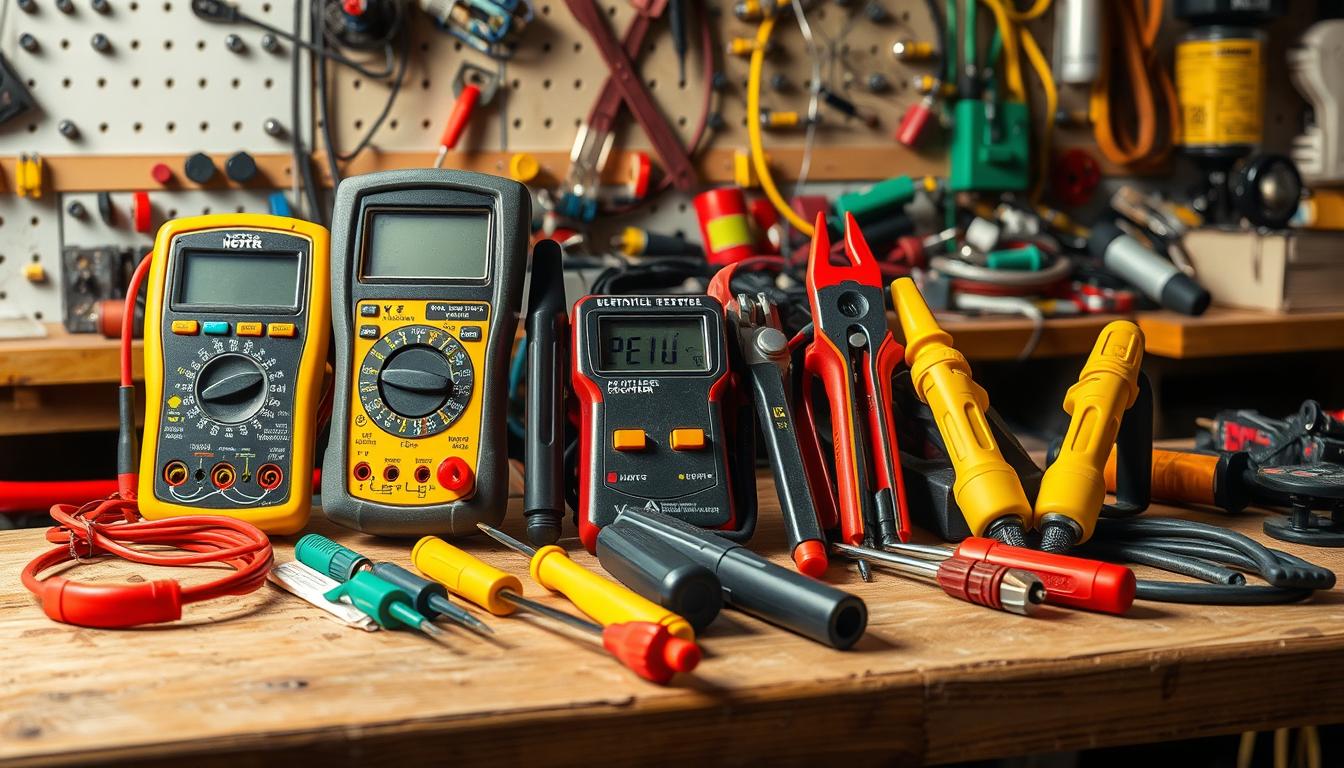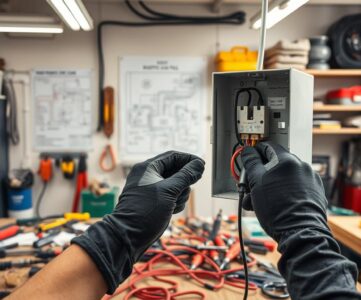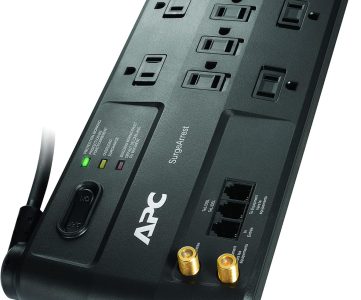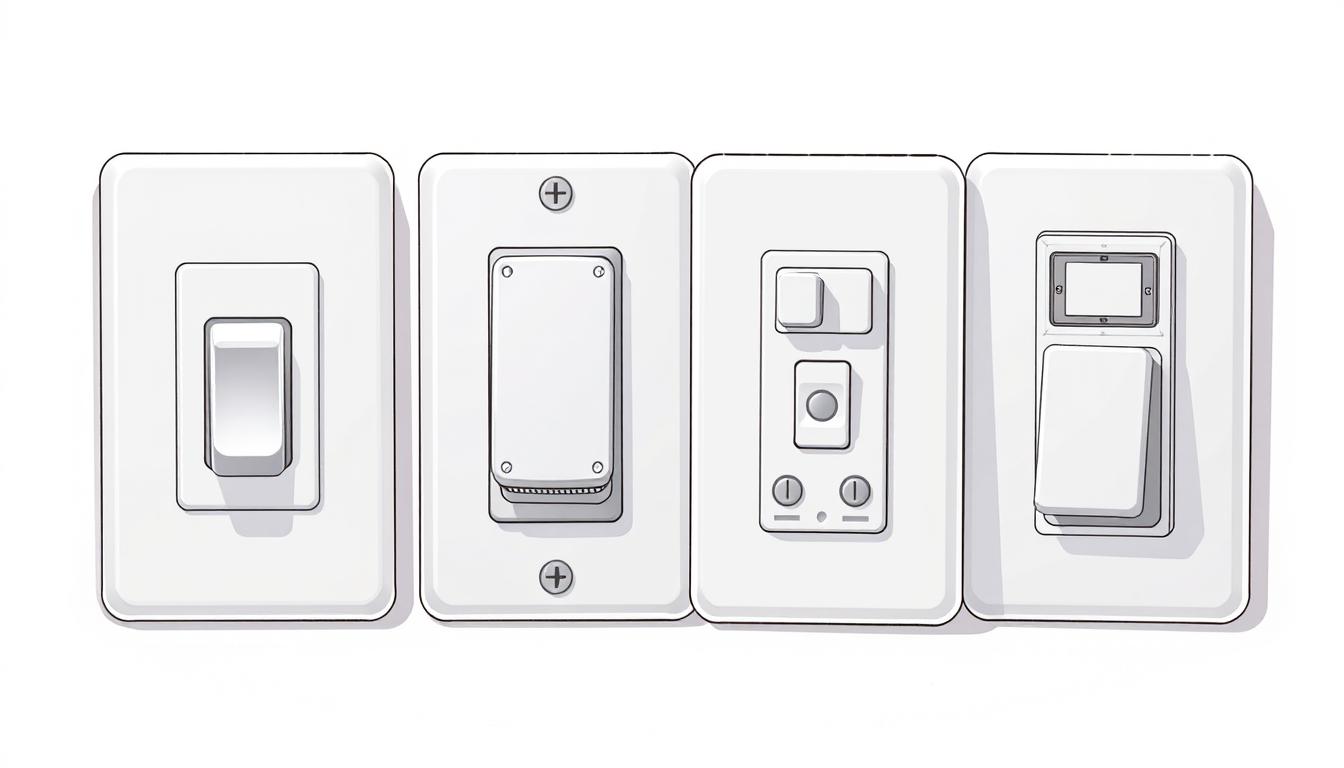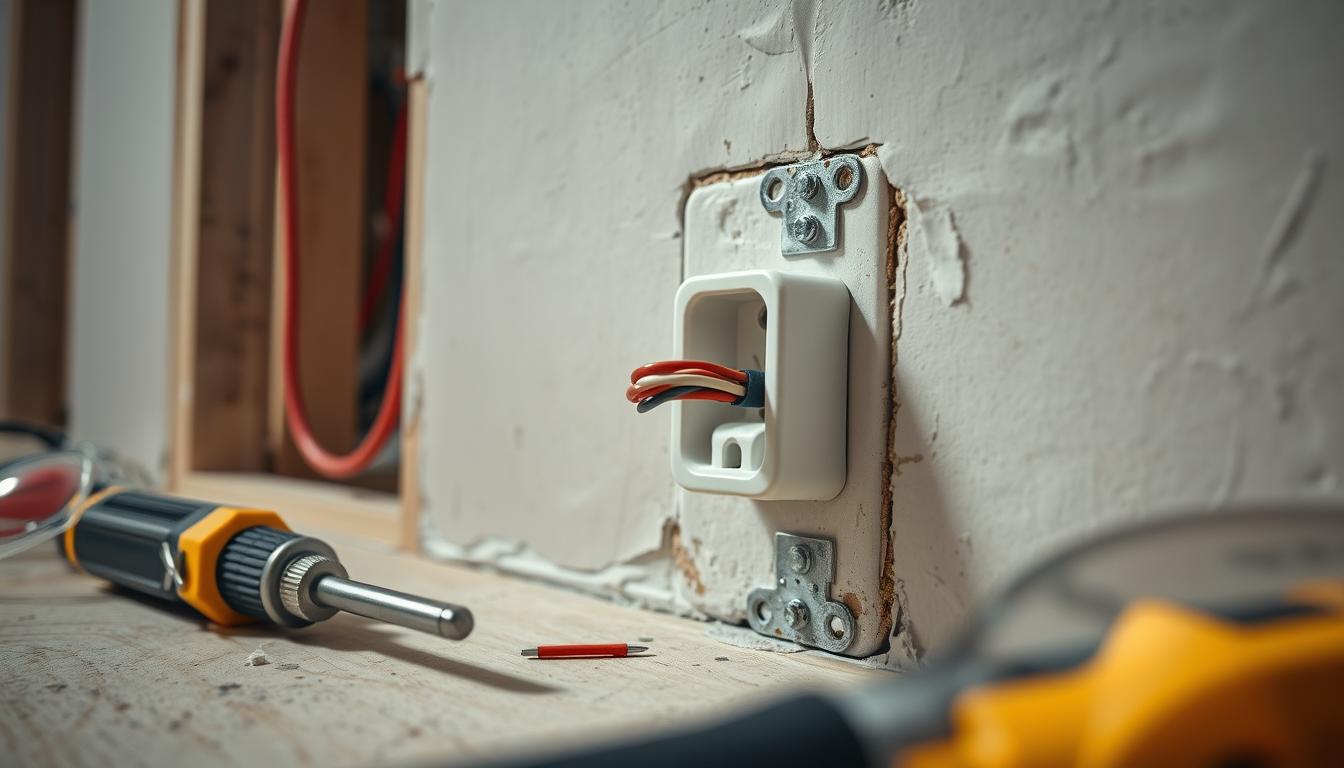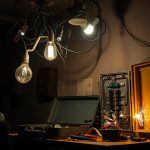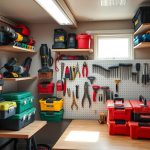As a DIYer, safety testing is key to avoid accidents and follow rules. You need electrical testing tools for any DIY project. These tools make testing electrical systems safe and effective.
Electrical testing uses tools like multimeters and non-contact voltage testers. These tools spot safety risks and check if electrical systems work right. Safety testing is vital in DIY electrical projects. Having the right tools is crucial for safe and effective work.
For electrical testing, the right safety gear is vital. You’ll need tools like multimeters, non-contact voltage testers, and circuit testers. These tools help you test electrical systems safely. They ensure you can find and fix safety issues. By getting the right tools, your DIY projects will be safe and successful.
Key Takeaways
- Electrical testing tools are essential for DIY projects
- Safety equipment, such as multimeters and non-contact voltage testers, is critical for safe testing
- Electrical testing helps identify potential safety hazards and ensures compliance with regulations
- Investing in the right electrical testing tools ensures safe and successful DIY projects
- Safety testing is a crucial step in any DIY electrical project
Understanding the Importance of Electrical Testing Tools
For DIY electrical projects, the right tools are key for safety and success. These tools help spot issues, find electrical currents, and avoid accidents. They ensure work is safe and meets legal standards, giving peace of mind and protecting against legal issues.
Important for DIY electrical work are safety principles like turning off power and wearing protective gear. Also, DIYers must follow legal requirements like getting permits and following local rules. Not doing so can lead to fines, injuries, or worse.
To ensure a safe and successful project, DIYers should know about:
- Electrical testing tools and their uses
- Basic safety rules, like lockout/tagout and protective gear
- Legal needs, such as permits and inspections
Understanding electrical testing tools and following safety and legal rules helps DIYers finish projects safely. This knowledge helps them handle electrical work well and ensures a safe outcome.
| Electrical Testing Tool | Purpose |
|---|---|
| Multimeter | Measures voltage, current, and resistance |
| Non-contact voltage tester | Detects electrical currents without touching wires |
| Circuit tester | Verifies circuit integrity and identifies faults |
Must-Have Safety Equipment Before Testing
Electrical testing needs the right safety equipment to avoid accidents and keep the work area safe. Multimeters and voltage testers are key for checking electrical currents and voltage levels.
DIYers should also get personal protective gear like insulated gloves and safety glasses. These help protect against electrical shock and other dangers in electrical testing.
Having these safety tools and equipment makes electrical testing safe and successful for DIYers.
Remember, safety should always be the top priority when working with electricity.
With the right safety gear and tools, including multimeters and voltage testers, DIYers can confidently do electrical testing projects. They can get professional-grade results.
Getting Started with Multimeters
Multimeters are key for anyone working with electricity. They help measure things like voltage, current, and resistance. We’ll look at the differences between digital multimeters and analog multimeters and what they do.
Knowing how to use multimeters is important for safe electrical work. It helps DIYers find and fix electrical issues. Whether you use digital multimeters or analog multimeters, understanding the readings is crucial.
Digital vs. Analog Multimeters
Digital multimeters are more popular because they’re accurate and easy to use. They show readings on an LCD screen. Analog multimeters, with their needle and dial, are still useful for some tasks.
Essential Multimeter Functions
Multimeters can do several important things:
- Measure voltage (AC and DC)
- Measure current (AC and DC)
- Measure resistance
- Do continuity tests
Reading and Interpreting Results
It’s important to know how to read multimeter results. You need to understand units like volts, amps, and ohms. By using the right multimeter and following the right steps, you can test electricity safely and accurately.
| Multimeter Type | Accuracy | Ease of Use |
|---|---|---|
| Digital Multimeters | High | Easy |
| Analog Multimeters | Lower | More challenging |
Non-Contact Voltage Testers: Your First Line of Defense
Having the right tools is key for safety testing. Non-contact voltage testers are vital for DIYers and electricians. They quickly show if a circuit is live without touching the wire.
These testers work by sensing the electromagnetic field around live wires. This lets users spot electrical dangers without risk. It’s a simple way to check for voltage.
Using a non-contact voltage tester is easy. Just hold it near the wire or outlet. It will show if there’s voltage. Some models even have LED lights or sounds to make it clear.
Here are some benefits of using non-contact voltage testers:
- Quick and easy to use
- Provides a safe way to test for voltage without making contact with the wire
- Can be used to test a variety of circuits and outlets
Adding non-contact voltage testers to your safety testing routine is smart. It keeps your work area safe and prevents electrical shock. Always follow the maker’s guide and be careful when dealing with live circuits.
Safety Testing Protocols for DIY Projects
When you work on electrical projects, it’s key to follow safety testing protocols. This helps avoid electrical shock and keeps your work area safe. A big part of this is making a pre-testing checklist.
This checklist should cover important safety steps. For example, it should check if power is off, use insulated tools, and wear protective gear. These steps are crucial for your safety.
A good pre-testing checklist is essential for safety. It helps you spot and fix potential dangers before you start. Also, keeping detailed records of your tests and steps is important. It helps you see how you’re doing and where you can get better. If something goes wrong, having emergency plans ready can prevent injuries and damage.
- Verify the absence of power before starting work
- Use insulated tools and personal protective equipment
- Check for any damage or wear on equipment and cables
By sticking to these safety steps and using a checklist, DIYers can work safely. It’s also vital to have emergency plans, like knowing what to do in case of shock or fire. Taking these steps helps keep you and others safe.
Circuit Testers and Their Applications
Circuit testers are key for finding electrical issues in many systems. They make sure electrical circuits are safe and work well. There are several types, like GFCI, continuity, and outlet testers.
GFCI Testers
GFCI testers check Ground Fault Circuit Interrupter outlets. These outlets keep people safe from electrical shock. They find out if an outlet is working right or needs a new one.
Continuity Testers
Continuity testers check if electrical circuits are complete. They spot any breaks or faults. This is crucial for safe and efficient electrical systems.
Outlet Testers
Outlet testers check the voltage and polarity of outlets. They see if an outlet is safe to use. These testers are used in homes and businesses.
The table below shows the different circuit testers and what they do:
| Tester Type | Application |
|---|---|
| GFCI Testers | Test Ground Fault Circuit Interrupter outlets |
| Continuity Testers | Test the continuity of electrical circuits |
| Outlet Testers | Test the voltage and polarity of electrical outlets |
Advanced Diagnostic Tools for Complex Projects
Working on complex projects requires the right tools for safety and efficiency. Tools like thermal imaging cameras and oscilloscopes are key for DIYers. They offer deep insights into electrical systems, making diagnoses and repairs more accurate.
Some top diagnostic tools include:
- Thermal imaging cameras: These cameras spot temperature differences in electrical systems. They help find issues early, preventing big problems.
- Oscilloscopes: These tools measure electrical signal voltage and current. They give detailed info about the system.
Using these tools, DIYers can finish complex projects safely and well. It’s important to pick the right tools for the job. Consider the electrical system type and project complexity. With the right tools and knowledge, DIYers can confidently handle complex electrical tasks.
Investing in advanced diagnostic tools is key for safe and successful electrical projects. Knowing the different tools and how to use them helps DIYers improve their projects.
| Diagnostic Tool | Description |
|---|---|
| Thermal Imaging Camera | Detects temperature differences in electrical systems |
| Oscilloscope | Measures voltage and current of electrical signals |
Common Electrical Testing Mistakes to Avoid
DIYers often make mistakes in electrical testing. One big mistake is misinterpreting readings from tools like multimeters. This happens when they don’t understand how the tool works or ignore the instructions.
Another error is tool maintenance errors. Not calibrating tools or not storing them right can cause wrong results or damage. Also, ignoring safety rules, like not wearing protective gear or not turning off power, is a mistake.
To avoid these mistakes, it’s key to follow the right testing steps and keep your tools in good shape. Here are some tips:
- Always read the manufacturer’s instructions before using a new tool
- Calibrate your tools regularly to ensure accuracy
- Store your tools properly to prevent damage
- Follow safety protocols, such as wearing protective gear and turning off the power supply before testing
By following these tips and knowing common electrical testing mistakes, you can have a safe and successful project. Always put safety and accuracy first when working with electrical systems. If you’re unsure, don’t hesitate to ask for professional help.
| Mistake | Consequence | Prevention |
|---|---|---|
| Misinterpreting readings | Inaccurate results | Follow manufacturer’s instructions, calibrate tools regularly |
| Tool maintenance errors | Damage to tools, inaccurate results | Store tools properly, calibrate regularly |
| Safety protocol violations | Safety hazards, injuries | Follow safety protocols, wear protective gear |
When to Call a Professional Instead of DIY Testing
Knowing when to call a pro for electrical testing is key. Professional electrical testing makes sure you follow the rules and avoid electrical shock. While DIY testing works for small tasks, it’s important to know its limits and when to ask for help.
Your safety is the most important thing. Safety testing rules are there to keep you safe from electrical dangers. If you’re not sure about electrical testing, it’s best to talk to a pro. They can guide you and make sure the testing is safe and done right.
Here are some times when you should get a pro for electrical testing:
- Complex electrical systems
- High-voltage testing
- Industrial or commercial electrical testing
It’s always safer to be careful with electrical testing. If you’re not sure about anything, don’t hesitate to call a professional. Your safety is worth it.
Electrical safety is not just a regulation, it’s a matter of life and death. Always prioritize safety when working with electricity.
| Testing Type | Recommended Approach |
|---|---|
| Simple DIY projects | DIY testing with proper safety protocols |
| Complex electrical systems | Professional electrical testing |
| High-voltage testing | Professional electrical testing |
Maintaining and Calibrating Your Testing Equipment
Keeping your testing equipment in top shape is key for getting accurate results. Regular calibration is a must to avoid mistakes and ensure everything works right. Having a good calibration plan helps DIYers keep their gear in perfect condition.
It’s important to store your equipment in a dry, cool spot, away from sunlight and moisture. This protects it from damage and makes it last longer. Also, having a specific place for your tools helps you find them easily and prevents loss.
Calibration Schedule
Creating a calibration schedule is based on how often you use your equipment. For instance, a daily-used multimeter might need more frequent checks than one used less often. Keeping records of these calibrations is also crucial for knowing your equipment is working right.
Storage Requirements
Storing your equipment properly is vital for its accuracy and reliability. This means using protective cases, keeping it away from harmful substances, and avoiding extreme temperatures. By doing this, you can make your testing equipment last longer and work better.
Replacement Guidelines
Testing equipment will eventually need to be replaced, no matter how well you maintain it. The decision to replace should be based on the manufacturer’s advice and the equipment’s condition. For example, a multimeter that’s no longer accurate or damaged should be replaced, even if it’s still within its calibration period. Following these guidelines ensures your equipment is always ready to use and gives you reliable results.
Conclusion: Ensuring Safe and Effective Electrical Testing
As we finish this guide on electrical testing tools, it’s clear that safety and reliable tools are key. Proper safety testing and using good diagnostic tools are vital for DIY electrical work. By following this guide, DIYers can make sure their electrical systems are safe and work well.
This guide has taught you the basics of multimeters and the importance of GFCI and continuity testers. It has given you the knowledge and confidence to handle many electrical testing tasks. Always follow safety rules, keep your tools in good shape, and know when to get a professional.
By focusing on safety and using the right tools, you can do your electrical projects with confidence. This ensures your family’s safety and keeps your home’s electrical system in good shape. Start your DIY journey with the knowledge and skills to do the job right.
